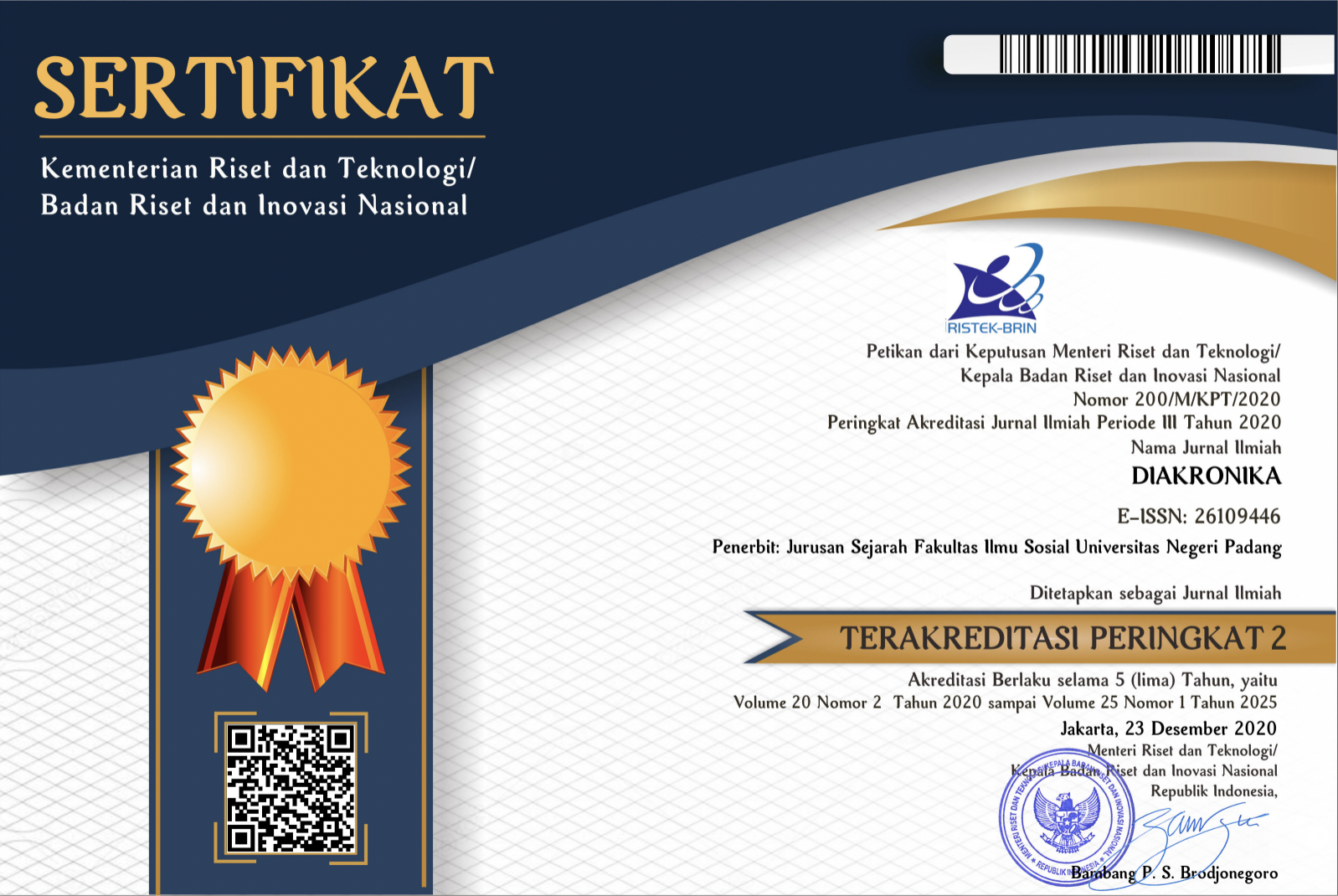Perkembangan Pembuatan Tenun Melayu Siak : Suatu Tinjauan Historis
Abstract
The siak weaving is a cultural heritage of Riau Malay. The motifs on the Siak Tenun have certain philosophical meanings. In addition, in the manufacturing process, there has been a development both from the materials and tools used. The study in this paper aims to describe the development of Siak weaving techniques based on the categories of materials and tools used from time to time. The method used in this study is the historical method with heuristic, verification, interpretation, and historiography stages. The result of the study is that the making of Siak Weaving has developed in terms of the materials and tools used. In terms of materials, at the beginning of its development using materials from silk, gold, and silver threads. However, since 1950 the weavers began to use cotton threads along with the high prices of silk, gold, and silver threads. Furthermore, in terms of tools, in 1764 the first weaving tool used was the tumpu loom. The tools used for the manufacture of Siaik weaving are increasingly developing, since 1990 it has been replaced by non-machine weaving tools (ATBM). The development of the Siak Tenun making tool to increase production output and shorten processing time. From the results of the study, it can be concluded that changes in the weaving production equipment affect the impact, including the number of workers, budget efficiency, quality, and quantity of production.
Downloads
References
Affendi, Y. (1989). Seni Tenun Silungkang dan Sekitarnya. Padang: Direktorat Jendral Kebudayaan Departemen pendidikan dan Kebudayaan Padang.
Akkapurlaura. (2015). Pengembangan Motif Rantai, Tampuk Manggis, Pucuk Rebung, Siku Awan, dan Lebah Bergayut Pada Kain Songket Melayu Riau. Prosiding Seminar Nasional Cendekiawan 2015. ISSN: 2460-8696.
Alajaji, T. N. (2019). Traditional Embroidery as a Method of Decoration in Najd Desert Tribes. J Textile Sci & Fashion Tech. 4(3),1-8. DOI: 10.33552/JTSFT.2019.04.000587
Dali, Z. (2016). Hubungan Antara Manusia, Masyarakat, dan Budaya Dalam Perspektif Islam. NUANSA, XI(1), 47-56.
Dariana, D. (2020). Penetapan Harga Pokok Produksi Dengan Metode Full Costing Sebagai Dasar Penentuan Harga Jual Kain Tenun Songket Melayu. JAS (Jurnal Akuntansi Syariah), 4(2), 258-270. https://doi.org/10.46367/jas.v4i2.247
Dasrol. (2013). Analisis Terhadap Hambatan Pelaksanaan Perlindungan Hukum Tenun Siak di Kabupaten Siak Berdasarkan Undang-Undang Nomor 19 Tahun 2002 Tentang Hak Cipta. Jurnal Hukum dan Pembangunan, 43(1), 1-26.
Encik Hasnah. Tokoh Perempuan Riau yang melestarikan Tenun Siak. Wawancara. Pekanbaru, 30 Juni 2009. Ia belajar menenun dari neneknya, Hajah Aminah, yang belajar dari Tengku Agung.
Falashifa, D. I. (2013). Kerajinan Tenun Ikat Tradisional Home Industry Dewi Shinta di Desa Troso Pecangan Kabupaten Jepara (Kajian Motif, Warna, Dan Makna Simbolik).Yogyakarta: Universitas Negeri Yogyakarta.
Galloway, P. (2006). Practicing Ethnohistory: Mining Archives, Hearing Testimony, Constructing Narratives. Lincoln: University of Nebraska Press.
Guslinda. (2017). Kerajinan Tenun Songket Melayu Riau Untuk Pelestarian Kearifan Lokal. JURNAL PIGUR, 2(1), 124-130.
Guslinda., Kurnia, R., & Munjiatun. (2020). The Development Of Social Studies Teaching Materials Based On Malay Siak Songket Weaving For Fourth Grade Elementary School Students. Jurnal PAJAR (Pendidikan dan Pengajaran), 4(5), 1057-1069. http://dx.doi.org/10.33578/pjr.v4i5.8089.
Ibrahim, B., Fikri, A., & Pernantah, PS. (2019). Integration of Siak Songket Weaving Values Through Value Clarification Technique to Reinforcement of the Meaningful History Learning. Proceedings of the International Conference On Social Studies, Globalisation And Technology (ICSSGT 2019). Advances in Social Science, Education and Humanities Research, volume 458, pg. 229-237. https://doi.org/
10.2991/assehr.k.200803.029
Jamil, O. K. N. (2006). Kain Tenunan Tradisional Siak. Siak Sri Indrapura: Seminar Kerajinan Tenunan Siak.
______________. Ketua LAM Siak dan Pengurus LAM Riau. Wawancara. Pekanbaru. 30 Oktober 2009. Ia bercerita berdasarkan kisah dari kedua orang tuanya, ibunya adalah anak angkat Tengku Maharatu, sementara ayahnya adalah sekretaris pribadi Sultan Syarif Kasim II.
Joko, T. P. (2009). Ilmu Budaya Dasar. Jakarta: Rineka Cipta
Kartiwa, S. (1981). Kain Songket Indonesia. Jakarta: Djambatan
Kistanto, N. (2017). Tentang Konsep Kebudayaan. Sabda: Jurnal Kajian Kebudayaan, 10 (2),1-11. https://doi.org/10.14710/sabda.10.2.%25p
Koentjaraningrat et al., (2007). Masyarakat Melayu dan Budaya Melayu Dalam Perubahan. Yogyakarta: Balai Kajian Dan Pengembangan Budaya Melayu.
Lestari, S. & Riyanti, M.T. (2017). Kajian Motif Tenun Songket Melayu Siak Tradisional Khas Riau. Jurnal Dimensi Dkv Seni Rupa Dan Desain, 2(1), 33-48.
Malik, A. et al., (2003). Corak dan Ragi Tenun Melayu Riau. Yogyakarta: Balai Kajian dan Pengembangan Budaya Melayu, Yogyakarta bekerja sama dengan Penerbit Adicita Karya Nusa.
Maulia, R. (2015). Wisata Budaya dalam Tradisi Tenun di Kecamatan Mempura Kabupaten Siak. JOM, 2(2), 1-11.
Muzayyan, C., & Ernawati. (2019). Studi Tentang Kain Tenun Siak di Usaha Ncik Hasnah Pekanbaru Riau. Journal of Public Policy Management and Administration, 1(1), 79-104.
Pitoyo, A.J., & Triwahyudi, H. (2017). Dinamika Perkembangan Etnis di Indonesia Dalam Konteks Persatuan Negara. Populasi, 25(1), 64-81. https://doi.org/10.22146/jp.32416
Prayogi, A. (2016). Dinamika Identitas Budaya Melayu Dalam Tinjauan Arkeo-Antropologis. Tamaddun: Jurnal Kebudayaan dan Sastra Islam, 16(1), 1-20.
Purwanti, R., & Siregar, S. M. (2016). Sejarah Songket Berdasarkan Data Arkeologi. Siddhayatra, 21(2), 97-106. https://doi.org/10.24832/
siddhayatra.v21i2.22
Rogers, J.D. (1993). Ethnohistory and Archaeology: Approaches to postcontact change in the Americas. New York and London: Plenum Press.
Roza, E. (2012). Tinjauan Sejarah Terhadap Naskah dan Teks Kitab Pengetahuan Bahasa, Kamus Logat Melayu Johor Pahang Riau Lingga Karya Raja Ali Haji. Jurnal Sosial Budaya, 9(2), 172-194.
Sirajuddin, M. (2014).Wacana Hukum Islam Lintas Budaya. Bogor: IPB Press
Strong, P.T. (2015). “Ethnohistory,” dalam J. D. Wright (ed.), International Encyclopedia of the Social and Behavioral Sciences, 8, 2nd ed. New York: Elsevier, 192–197.
Suadnyana, I. B. P. E. (2020). Kain Tenun Cagcag pada Upacara Manusa Yadnya di Kelurahan Sangkaragung Kabupaten Jembrana. Jñānasiddhânta: Jurnal Prodi Teologi Hindu STAHN, 2 (1), 51-60.
Sutrisno, P. (2012). Seluk Beluk Tenunan Siak. Pekanbaru: UR Press.
Wahyudi, J., & dan Maulida, I. (2019). Pengenalan Pola Citra Kain Tradisional Menggunakan GLCM dan KNN. JTIULM, 4 (2), 43–48. https://doi.org/
10.20527/jtiulm.v4i2.37
Wilaela. (2014). Sultanah Latifah School Di Kerajaan Siak (1927-1945). Sosial Budaya: Media Komunikasi Ilmu-Ilmu Sosial dan Budaya, 11(1), 124-143. http://dx.doi.org/10.24014/sb.v11i1.831
________. (2015). Pendidikan Jalan Tengah Di Kerajaan Siak (1915-1945). Sosial Budaya: Media Komunikasi Ilmu-Ilmu Sosial dan Budaya , 12 (1), 117-126. http://dx.doi.org/10.24014/sb.v12i1.1929




